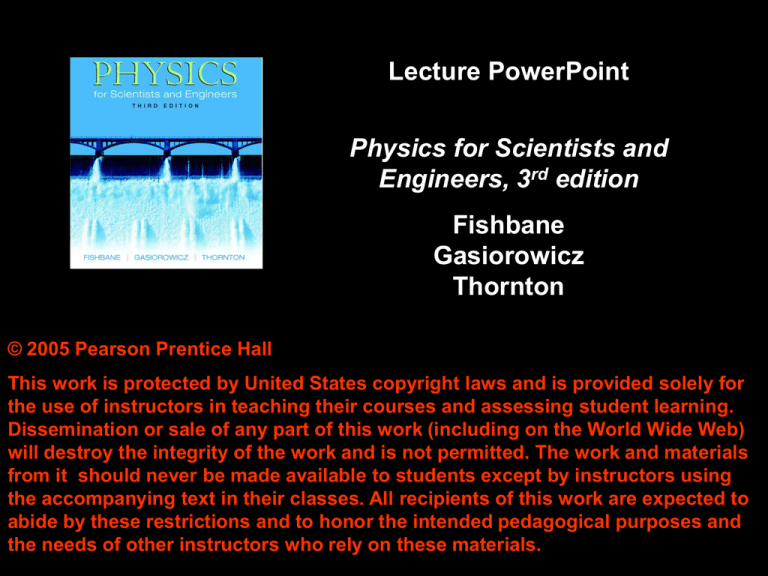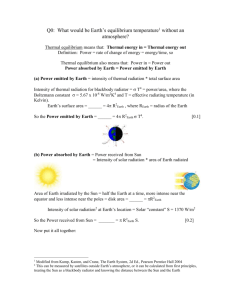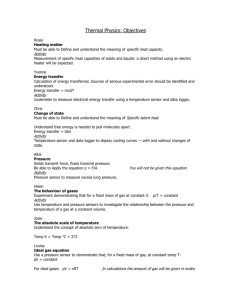
Lecture PowerPoint
Physics for Scientists and
Engineers, 3rd edition
Fishbane
Gasiorowicz
Thornton
© 2005 Pearson Prentice Hall
This work is protected by United States copyright laws and is provided solely for
the use of instructors in teaching their courses and assessing student learning.
Dissemination or sale of any part of this work (including on the World Wide Web)
will destroy the integrity of the work and is not permitted. The work and materials
from it should never be made available to students except by instructors using
the accompanying text in their classes. All recipients of this work are expected to
abide by these restrictions and to honor the intended pedagogical purposes and
the needs of other instructors who rely on these materials.
Chapter 17
Temperature and Ideal Gases
Main Points of Chapter 17
• Temperature, thermal equilibrium, the zeroth
law of thermodynamics
• Ideal gases, absolute temperature
• Thermal expansion
• Equation of state for gases
• Blackbody radiation
17-1 Temperature and Thermal Equilibrium
The zeroth law of thermodynamics:
If two thermal systems are in thermal equilibrium
with one another, then they have the same
temperature.
If two systems are each in thermal equilibrium with
a third, then they are in thermal equilibrium with
one another.
17-1 Temperature and Thermal Equilibrium
The zeroth law of thermodynamics (cont):
Thermal reservoir: system so large that its
temperature doesn’t change when interacting with
other systems
Thermal contact can occur through conduction,
convection, and radiation
17-1 Temperature and Thermal Equilibrium
Thermometer: a device that measures temperature
quantitatively
• Minimal effect on system being measured
• Good contact with system being measured
• Reproducible and easily read scale
17-1 Temperature and Thermal Equilibrium
Properties useful for thermometry:
• Thermal expansion of fluids and solids
• Pressure of gases
• Reflective properties
• Electric and magnetic properties
• Color
17-1 Temperature and Thermal Equilibrium
Some Thermometers
17-2 Ideal Gases and Absolute Temperature
Product of pressure and volume, divided by amount
of gas, increases if thermal reservoir is hotter and
decreases if it is colder.
Therefore, define temperature:
For an ideal gas at constant volume,
(17-1)
17-2 Ideal Gases and Absolute Temperature
To set temperature scale:
Define T = 0 as point where pressure would
become zero – absolute zero
Then use triple point of water – where water
vapor, liquid water, and ice coexist – to define
scale
Defined as T = 273.16K (Kelvin)
Next slide shows some temperatures
occurring in nature, in K
17-2 Ideal Gases and Absolute Temperature
17-2 Ideal Gases and Absolute Temperature
Other temperature scales:
Celsius: tC = 0° at freezing point of water,
tC = 100° at boiling point
(17-3)
Fahrenheit: tF = 32° at freezing point of water,
tF = 212° at boiling point
(17-4)
17-2 Ideal Gases and Absolute Temperature
Comparison of Temperature Scales
17-3 Thermal Expansion
Solids expand when temperature increases;
describe by coefficient of thermal expansion:
(17-5)
For fluids, use coefficient of volume expansion
instead (as length is not well-defined)
(17-6)
17-3 Thermal Expansion
17-4 The Equation of State of Gases
One mole of gas has a mass in grams equal to the
atomic or molecular weight of the gas.
Example: The atomic weight of helium is 4; one
mole of helium has a mass of 4 grams.
17-4 The Equation of State of Gases
One mole always has the same number of atoms
or molecules, called Avogadro’s number:
The number of atoms or molecules in a sample of
gas can then be written in terms of NA and n, the
number of moles:
(17-8)
17-4 The Equation of State of Gases
For constant temperature, ideal gases obey
Boyle’s law:
(17-9)
Combine that with earlier result for
constant volume:
(17-1)
to get the ideal gas law:
(17-10)
where:
(17-11)
17-4 The Equation of State of Gases
Alternatively, can write:
(17-12)
where N is the number of atoms or molecules,
and:
(17-13)
k is called Boltzmann’s constant.
17-4 The Equation of State of Gases
The state of an ideal gas is described by its
temperature, volume, pressure, and number of
atoms or molecules (which is usually assumed
to stay the same). Changing any one, or more,
of these results in a change of the state.
Several types of changes are commonly used:
• isothermal: temperature is constant
• isobaric: pressure is constant
17-4 The Equation of State of Gases
How Close do Real Gases Come to Being Ideal?
• They need to be dilute, although how dilute depends on
how close to ideal the gas needs to be
• They get closer and closer to being ideal as the
temperature drops
• Monatomic gases are closer to being ideal over a wider
range of temperatures than polyatomic gases
17-4 The Equation of State of Gases
How Close do Real Gases Come to Being Ideal?
Better equation for real gases: van der Walls
(17-15)
The constants a and b depend on the specific gas.
17-5 Blackbody Radiation
Objects that become sufficiently hot will glow
visibly; as they get hotter they go from red, to
yellow, to a bluish white.
This is electromagnetic radiation; objects at any
temperature will emit it at various frequencies,
from radio waves all the way to gamma rays.
17-5 Blackbody Radiation
This radiation from a body in thermal equilibrium
is called blackbody radiation, as it is purely
thermal and doesn’t depend on any properties of
the body other than its temperature and area.
17-5 Blackbody Radiation
Deriving the energy density as a function of
frequency and temperature required introducing
some new concepts:
(17-16)
Here, c is the speed of light:
And h is Planck’s constant:
17-5 Blackbody Radiation
This formula for blackbody radiation was one
of the first hints of the necessity of quantum
theory to describe matter and radiation.
Stefan-Boltzmann formula gives power
radiated as a function of temperature:
(17-17)
17-5 Blackbody Radiation
The Discovery and Measurement of the Background
Radiation of the Universe
In 1964, background radiation was discovered, coming
from no particular source but having a blackbody
frequency distribution corresponding to a temperature
of about 3K.
This radiation is left over from the early days of the
universe.
17-5 Blackbody Radiation
The Discovery and Measurement of the Background
Radiation of the Universe
At first, matter and radiation were in thermal
equilibrium; as the universe cooled this was no longer
true. The blackbody radiation is the remnant of the
frozen-out radiation, cooled to near absolute zero by
the expansion of the universe.
17-5 Blackbody Radiation
This is the observed
blackbody radiation data
as well as the distribution
for T = 2.735K. The error
bars on the data points are
smaller than the points
themselves.
Summary of Chapter 17
• Kelvin temperature scale is defined by the
triple point of water, T = 273.16K, and absolute
zero, T = 0K.
• If gas is sufficiently dilute, obeys the ideal gas
law:
(17-10, 12)
(17-11)
(17-13)
Summary of Chapter 17
• Real gases are better described by van der
Waals equation of state:
(17-15)
• Materials expand when heated, described by
coefficient of thermal expansion:
(17-5)
Summary of Chapter 17
• Thermal radiation is described by the
Stefan-Boltzmann relation for power:
(17-17)
• and the Planck formula for energy density:
(17-16)





